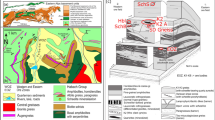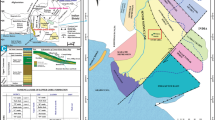Abstract
Drilling recovered the upper part (23 m) of the upland loess–paleosol series (LPS) on the right bank of the Kuma River near the Otkaznoe Settlement. Description of cores and laboratory analyses made it possible to carry out lithostratigraphic subdivision of the loess sequence in the summary column. Four paleosol units separated by loess horizons are identified. The two lower contiguous paleosols are defined well in the cores by their dark brown color and high values of magnetic susceptibility. The other two paleosols are weakly expressed and identified mainly by variations in the mechanical composition and contents of organic matter and carbonates. Analysis of 13 luminescence dates obtained in two different laboratories (four dates at Karpinsky Russian Research Geological Institute (VSEGEI), St. Petersburg, Russia; nine dates at Leibniz Institute for Applied Geophysics (LIAG), Hannover, Germany) shows that the LPS belongs to the Late Pleistocene and Holocene. Based on the dates, three (two Bayesian and one linear) depth-age models were constructed. The linear model is in better agreement with the stratigraphic sequence and the cross-regional loess correlation. The age of boundaries of the stratigraphic units was calculated, and a preliminary correlation with the marine oxygen isotope stages (MIS) was carried out: soil S0—MIS 1; loess L1LL1—MIS 2; paleosol L1SS1—MIS 3; loess L1LL2—MIS 4; paleosol S1SS1—MIS 5a; loess S1LL1—MIS 5b; paleosol S1SS2—MIS 5c; loess S1LL2—MIS 5d; and paleosol S1SS3—MIS 5e. Calculations of the sedimentation rate yielded the following results: minimum growth rate of the loess sequence in the Holocene (9 cm/ka) and Mikulino time (10 cm/ka); maximum rate, at the end of the middle–beginning of the late Valdaian (79 cm/ka). Pedostratigraphy and compositional variations give grounds for correlating the summary column with the core of reference Borehole-1 drilled in the Otkaznoe Settlement in 1986.




Similar content being viewed by others
Notes
Italicized are paleosol names, according to (Velichko et al., 2009, 2012, 2017).
Average (minimum–maximum) age.
REFERENCES
Astakhov, V., Pestova, L., and Shkatova, V., Loessoids of Russia: Varieties and distribution, Quat. Int., 2022, vol. 620, pp. 24–35. https://doi.org/10.1016/j.quaint.2021.01.005
Balaev, L.G. and Tsarev, P.V., Lessovye porody Tsentral’nogo i Vostochnogo Predkavkaz’ya (Loess Rocks in Central and Eastern Ciscaucasia), Moscow: Nauka, 1964.
Bolikhovskaya, N.S., Evolyutsiya lessovo-pochvennoi formatsii Severnoi Evrazii (Evolution of the Loess–Soil Formation in Northern Eurasia). Moscow: MGU, 1995.
Bolikhovskaya, N.S., Markova, A.K., and Faustov, S.S., Changes of landscape–climate conditions in the Terek–Kuma lowland in the Pleistocene, Vestn. MGU, Ser Geogr., 2015, no. 1, pp. 55–70.
Bolikhovskaya, N.S., Faustov, S.S., and Markova, A.K., Pleistocene climatic stratigraphy and environments of the Terek–Kuma Lowland (NW Caspian sea region) inferred from palynological, paleomagnetic and rodent records of the long Otkaznoye sediment sequence, Quat. Int., 2016, vol. 409, pp. 16–32. https://doi.org/10.1016/j.quaint.2015.09.067
Chen, J., Yang, T., Matishov, G.G., et al., A luminescence dating study of loess deposits from the Beglitsa section in the Sea of Azov, Russia, Quat. Int., 2018a, vol. 478, pp. 27–37. https://doi.org/10.1016/j.quaint.2017.11.017
Chen, J., Yang, T., Matisho, G.G., et al., Luminescence chronology and age model application for the upper part of the Chumbur-Kosa loess sequence in the Sea of Azov, Russia, J. Mt. Sci., 2018b, vol. 15, no. 3, pp. 504–518. https://doi.org/10.1007/s11629-017-4689-0
Cohen, K.M. and Gibbard, P.L., Global chronostratigraphical correlation table for the last 2.7 million years, version 2019 QI-500, Quat. Int., 2019, vol. 500, pp. 20–31. https://doi.org/10.1016/j.quaint.2019.03.009
Galai, B.F., Lithogenesis and collapsibility of eolian loesses: Example from central Ciscaucasia, Abstract of DSc (Geol.–Miner.) Dissertation, Moscow: MGU, 1992.
Haase, D., Fink, J., Haas, G., et al., Loess in Europe – its spatial distribution based on a European Loess Map, Scale 1 : 2 500 000, Quat. Sci. Rev., 2007, vol. 26, no. 9, pp. 1301–1312. https://doi.org/10.1016/j.quascirev.2007.02.003
Heiri, O., Lotte, A.F., and Lemcke, G., Loss on ignition as a method for estimating organic and carbonate content in sediments: reproducibility and comparability of results, J. Paleolimnol., 2001, vol. 25, pp. 101–110. https://doi.org/10.1023/A:1008119611481
Jary, Z. and Ciszek, D., Late Pleistocene loess-palaeosol sequences in Poland and western Ukraine, Quat. Sci. Rev., 2013, vol. 296, pp. 37–50. https://doi.org/10.1016/j.quaint.2012.07.009
Kars, R.H., Wallinga, J., and Cohen, K., A new approach towards anomalous fading correction for feldspar IRSL dating – tests on samples in field saturation, Radiat. Meas., 2008, vol. 43, pp. 786–790. https://doi.org/10.1016/j.radmeas.2008.01.021
Konstantinov, E.A., Mazneva, E.A., Sychev, N.V., et al., Regularities in the spatial variability of Late Pleistocene and Holocene loesses in Ciscaucasia, Geogr. Prirodn. Resursy, 2020, no. 3, pp. 98–107.
Kukla, J., Correlations between loesses and deep-sea sediments, Geol. Foren. Stockholm: Förhandl., 1970, vol. 92, pp. 148–180.
Kukla, J., Pleistocene land-sea correlations I. Europe, Earth-Sci. Rev., 1977, vol. 13, pp. 307–374.
Makeev, A., Lebedeva, M., Kaganova, A., et al., Pedosedimentary environments in the Caspian lowland during MIS5 (Srednaya Akhtuba reference section, Russia), Quat. Int., 2021, vol. 590, pp. 164–180. https://doi.org/10.1016/j.quaint.2021.03.015
Marković, S.B., Bokhorst, M.P., Vandenberghe, J., et al., Late Pleistocene loess–palaeosol sequences in the Vojvodina region, north Serbia, J. Quat. Sci., 2007, vol. 23, no. 1, pp. 73–84.
Marković, S.B., Stevens, T., Kukla, G.J., et al., Danube loess stratigraphy—towards a pan-European loess stratigraphic model, Earth-Sci. Rev., 2015, vol. 148 P, pp. 228–258.
Mazneva, E., Konstantinov, E., Zakharov, A., et al., Middle and Late Pleistocene loess of the Western Ciscaucasia: Stratigraphy, lithology and composition, Quat. Int., 2021, vol. 590, pp. 146–153. https://doi.org/10.1016/j.quaint.2020.11.039
Molodkov, A.N. and Bolikhovskaya, N.S., Climato-chronostratigraphic framework of the Pleistocene terrestrial and marine deposits of Northern Eurasia, based on pollen, electron spin resonance, and infrared optically stimulated luminescence analyses, Eston. J. Earth Sci., 2010, vol. 59, no. 1, pp. 49–62.
Murray, A.S. and Wintle, A.G., The single aliquot regenerative dose protocol: potential for improvements in reliability, Radiat. Meas., 2004, vol. 37, no. 4, pp. 377–381.
Opornye inzhenerno-geologicheskie razrezy lessovykh porod Severnoi Evrazii (Reference Engineering-Geological Sections of Loess Rocks in Northern Eurasia), Trofimov, V.T., Ed., Moscow, KDU, 2008.
Pechi, M., Loess is not just the accumulation of dust, Quat. Int., 1990, vol. 7/8, pp. 1–21.
Pye, K., The nature, origin and accumulation of loess, Quat. Sci. Rev., 1995, vol. 14, pp. 653–667.
Shelkoplyas, V.N., Kulikova, L.S., and Galai, B.F., Geochronology of loess sequences in central Ciscaucasia based on the thermoluminescence and paleomagnetic data, in Inzhenerno-geologicheskie osobennosti tsiklichnosti lessov (Engineering-Geological Peculiarities of the Cyclicity of Loesses), Trofimov, V.T. and Shaevich, Ya.E., Eds., Moscow: Nauka, 1987, pp. 109–114.
Thiel, C., Buylaert, J.P., Murray, A.S., et al., Luminescence dating of the Stratzing loess profile (Austria) - Testing the potential of an elevated temperature post-IR IRSL protocol, Quat. Int., 2011, vol. 234, no. 1/2, pp. 23–31. https://doi.org/10.1016/j.quaint.2010.05.018
Udartsev, V.P., Bolikhovskaya, N.S., and Virina, E.I., Reference sections, chronostratigraphy, and paleogeography of loess sequences in the Ciscaucasian loess region, in Inzhenernaya geologiya lessovykh porod (Engineering Geology of Loess Rocks), Rostov-on-Don, 1989, pp. 102–103.
Velichko, A.A., Katto, N.R., Tesakov, A.S., et al., Structural specificity of Pleistocene loess and soil formation of the southern Russian Plain according to materials of eastern Priazovie, Dokl. Earth Sci., 2009, vol. 428, no. 6, pp. 1364–1368. https://doi.org/10.1134/S1028334X09080273
Velichko, A.A., Morozova, T.D., Borisova, O.K., et al., Development of the steppe zone in southern Russia based on the reconstruction from the loess-soil formation in the Don–Azov region, Dokl. Earth Sci., 2012, vol. 445, no. 4, pp. 999–1002.
Velichko, A.A., Yang, T., Alekseev, A.O., et al., Comparative analysis of variations in sedimentation conditions over the past interglacial–glacial megacycles in loess areas on the southern East European Plain (Azov region) and central China (loess plateau), Geomorfologiya. 2017, no. 1, pp. 3–18.
Virina, E.I. and Udartsev, V.P., Paleomagnetic stratigraphy of loess–soil deposits in Ciscaucasia, in Chetvertichnyi period: Metody issledovaniya, stratigrafiya, ekologiya (Quaternary Period: Investigation Methods, Stratigraphy, and Ecology), Tallinn, 1990, vol. 1, pp. 19–20.
Virina, E.I., Faustov, E.I., and Heller, F., Magnetism of loess-palaeosol formations in relation to soil-forming and sedimentary processes, Phys. Chem. Earth, 2000, vol. 25, no. 5, pp. 475–478.
ACKNOWLEDGMENTS
The team of authors is grateful to D.V. Baranov, N.T. Tkach, V.S. Shishkin, E.A. Mazneva, and N.V. Karpukhina for invaluable help in field work, as well as to K.G. Filippova and D.G. Sycheva for help in preparation of the article.
Funding
Luminescence dating was supported by the Russian Science Foundation, project no. 21-77-10104. Field research was carried out under state tasks of the Institute of Geography, Russian Academy of Sciences AAAA-A19-119021990092-1 (FMWS-2019-0008).
Author information
Authors and Affiliations
Corresponding author
Additional information
Translated by D. Sakya
Rights and permissions
About this article
Cite this article
Sychev, N.V., Konstantinov, E.A., Zakharov, A.L. et al. New Data on Geochronology of the Upper Quaternary Loess–Soil Series in the Terek–Kuma Lowland. Lithol Miner Resour 57, 336–347 (2022). https://doi.org/10.1134/S0024490222040071
Received:
Revised:
Accepted:
Published:
Issue Date:
DOI: https://doi.org/10.1134/S0024490222040071




